Root Distribution of Tomato Cultivated in Greenhouse under Different Ventilation and Water Conditions
Abstract
1. Introduction
2. Results
2.1. Meteorological, Soil Water and Temperature Condition
2.1.1. Variations in Meteorological Factors
2.1.2. Variations in Soil Water and Temperature
2.2. Distribution of Root Length Density
2.3. Development of the NRLD Model
2.4. Validation and Application of the NRLD Distribution Model
2.4.1. Validation
2.4.2. Application
2.5. Root System and Yield
3. Discussion
3.1. Effect of Ventilation Mode and Irrigation Amount on Greenhouse Environment
3.2. Effect of Ventilation Mode and Irrigation Amount on RLD Distribution
3.3. Performance of NRLD Distribution Models in Different Ventilation Mode and Irrigation Amount
3.4. Application of the NRLD Distribution Model
3.5. Effect of Ventilation and Irrigation Amount on Tomato Yield
4. Materials and Methods
4.1. Experimental Site and Design
4.2. Measurement
4.2.1. Environmental Factors
4.2.2. Soil Water Content
4.2.3. Soil Temperature
4.2.4. Root Distribution
4.2.5. Yield
4.3. Root Length Density Distribution Model
4.4. Model Evaluation
5. Conclusions
Author Contributions
Funding
Data Availability Statement
Conflicts of Interest
References
- Zhen, H.; Gao, W.; Jia, L.; Qiao, Y.; Ju, X. Environmental and economic life cycle assessment of alternative greenhouse vegetable production farms in peri-urban Beijing, China. J. Clean. Prod. 2020, 269, 122380. [Google Scholar] [CrossRef]
- Wei, Z.; Du, T.; Li, X.; Fang, L.; Liu, F. Interactive Effects of Elevated CO2 and N Fertilization on Yield and Quality of Tomato Grown under Reduced Irrigation Regimes. Front. Plant Sci. 2018, 9, 328. [Google Scholar] [CrossRef] [PubMed]
- Ghannem, A.; Ben Aissa, I.; Majdoub, R. Effects of regulated deficit irrigation applied at different growth stages of greenhouse grown tomato on substrate moisture, yield, fruit quality, and physiological traits. Environ. Sci. Pollut. Res. 2021, 28, 46553–46564. [Google Scholar] [CrossRef] [PubMed]
- Zapata-Sierra, A.; Moreno-Pérez, M.; Reyes-Requena, R.; Manzano-Agugliaro, F. Root distribution with the use of drip irrigation on layered soils at greenhouses crops. Sci. Total. Environ. 2021, 768, 144944. [Google Scholar] [CrossRef] [PubMed]
- Ji, T.; Guo, X.; Wu, F.; Wei, M.; Li, J.; Ji, P.; Wang, N.; Yang, F. Proper irrigation amount for eggplant cultivation in a solar greenhouse improved plant growth, fruit quality and yield by influencing the soil microbial community and rhizosphere environment. Front. Microbiol. 2022, 13, 981288. [Google Scholar] [CrossRef] [PubMed]
- Gong, X.; Li, X.; Li, Y.; Bo, G.; Qiu, R.; Huang, Z.; Gao, S.; Wang, S. An improved model to simulate soil water and heat: A case study for drip-irrigated tomato grown in a greenhouse. Agric. Water Manag. 2023, 277, 108121. [Google Scholar] [CrossRef]
- Hu, J.; Gettel, G.; Fan, Z.; Lv, H.; Zhao, Y.; Yu, Y.; Wang, J.; Butterbach-Bahl, K.; Li, G.; Lin, S. Drip fertigation promotes water and nitrogen use efficiency and yield stability through improved root growth for tomatoes in plastic greenhouse production. Agric. Ecosyst. Environ. 2021, 313, 107379. [Google Scholar] [CrossRef]
- Shabbir, A.; Mao, H.; Ullah, I.; Buttar, N.A.; Ajmal, M.; Solangi, K.A. Improving Water Use Efficiency by Optimizing the Root Distribution Patterns under Varying Drip Emitter Density and Drought Stress for Cherry Tomato. Agronomy 2021, 11, 3. [Google Scholar] [CrossRef]
- Wu, J.; Zhang, R.; Gui, S. Modeling soil water movement with water uptake by roots. Plant Soil 1999, 215, 7–17. [Google Scholar] [CrossRef]
- Zuo, Q.; Shi, J.; Li, Y.; Zhang, R. Root length density and water uptake distributions of winter wheat under sub-irrigation. Plant Soil 2006, 285, 45–55. [Google Scholar] [CrossRef]
- Ning, S.; Chen, C.; Zhou, B.; Wang, Q. Evaluation of normalized root length density distribution models. Field Crops Res. 2019, 242, 107604. [Google Scholar] [CrossRef]
- Li, Y.; Niu, W.; Dyck, M.; Wang, J.; Zou, X. Yields and Nutritional of Greenhouse Tomato in Response to Different Soil Aeration Volume at two depths of Subsurface drip irrigation. Sci. Rep. 2016, 6, 39307. [Google Scholar] [CrossRef] [PubMed]
- Gázquez, J.; Lopez, J.; Pérez-Parra, J.; Baeza, E.; Sáez, M.; Parra, A. Greenhouse Cooling Strategies for Mediterranean Climate Areas. Acta Hortic. 2008, 45, 425–432. [Google Scholar] [CrossRef]
- Tantau, H.-J.; Lange, D. Greenhouse climate control: An approach for integrated pest management. Comput. Electron. Agric. 2003, 40, 141–152. [Google Scholar] [CrossRef]
- Babalola, O.; Fawusi, M.O.A. Drought susceptibility of two tomato (Lycopersicum esculentum) varieties. Plant Soil 1980, 55, 205–214. [Google Scholar] [CrossRef]
- Sacco, A.; Greco, B.; Di Matteo, A.; De Stefano, R.; Barone, A. Evaluation of Tomato Genetic Resources for Response to Water Deficit. Am. J. Plant Sci. 2013, 04, 131–145. [Google Scholar] [CrossRef]
- Ullah, I.; Mao, H.; Rasool, G.; Gao, H.; Javed, Q.; Sarwar, A.; Khan, M. Effect of Deficit Irrigation and Reduced N Fertilization on Plant Growth, Root Morphology, and Water Use Efficiency of Tomato Grown in Soilless Culture. Agronomy 2021, 11, 228. [Google Scholar] [CrossRef]
- Mardani, S.; Tabatabaei, S.H.; Pessarakli, M.; Zareabyaneh, H. Physiological responses of pepper plant (Capsicum annuum L.) to drought stress. J. Plant Nutr. 2017, 40, 1453–1464. [Google Scholar] [CrossRef]
- Niu, W.-Q.; Jia, Z.-X.; Zhang, X.; Shao, H.-B. Effects of Soil Rhizosphere Aeration on the Root Growth and Water Absorption of Tomato. CLEAN—Soil Air Water 2012, 40, 1364–1371. [Google Scholar] [CrossRef]
- Howell, T.; Moriconi, J.I.; Zhao, X.; Hegarty, J.; Fahima, T.; Santa-Maria, G.E.; Dubcovsky, J. A wheat/rye polymorphism affects seminal root length and yield across different irrigation regimes. J. Exp. Bot. 2019, 70, 4027–4037. [Google Scholar] [CrossRef]
- Zubaidi, A.; McDonald, G.K.; Hollamby, G.J. Shoot growth, root growth and grain yield of bread and durum wheat in South Australia. Aust. J. Exp. Agric. 1999, 39, 709–720. [Google Scholar] [CrossRef]
- Novák, V. Water uptake of maize roots under conditions of non-limiting soil water content. Soil Technol. 1994, 7, 37–45. [Google Scholar] [CrossRef]
- Yang, D.; Zhang, T.; Zhang, K.; Greenwood, D.J.; Hammond, J.P.; White, P.J. An easily implemented agro-hydrological procedure with dynamic root simulation for water transfer in the crop–soil system: Validation and application. J. Hydrol. 2009, 370, 177–184. [Google Scholar] [CrossRef]
- Zuo, Q.; Jie, F.; Zhang, R.; Meng, L. A Generalized Function of Wheat’s Root Length Density Distributions. Vadose Zone J. 2004, 3, 271–277. [Google Scholar] [CrossRef]
- Yadav, B.K.; Mathur, S. Modeling Soil Water Uptake by Plants Using Nonlinear Dynamic Root Density Distribution Function. J. Irrig. Drain. Eng. 2008, 134, 430–436. [Google Scholar] [CrossRef]
- Novák, V. Estimation of soil-water extraction patterns by roots. Agric. Water Manag. 1987, 12, 271–278. [Google Scholar] [CrossRef]
- Metselaar, K.; Pinheiro, E.A.R.; Lier, Q.D.J.V. Mathematical Description of Rooting Profiles of Agricultural Crops and its Effect on Transpiration Prediction by a Hydrological Model. Soil Syst. 2019, 3, 44. [Google Scholar] [CrossRef]
- Gong, X.W.; Qiu, R.J.; Sun, J.S.; Ge, J.K.; Li, Y.B.; Wang, S.S. Evapotranspiration and crop coefficient of tomato grown in a solar greenhouse under full and deficit irrigation. Agric. Water Manag. 2020, 235, 106154. [Google Scholar] [CrossRef]
- Chandran, U.S.S.; Tarafdar, A.; Mahesha, H.S.; Sharma, M. Temperature and Soil Moisture Stress Modulate the Host Defense Response in Chickpea during Dry Root Rot Incidence. Front. Plant Sci. 2021, 12, 653265. [Google Scholar] [CrossRef]
- Lahti, M.; Aphalo, P.J.; Finer, L.; Ryyppo, A.; Lehto, T.; Mannerkoski, H. Effects of soil temperature on shoot and root growth and nutrient uptake of 5-year-old Norway spruce seedlings. Tree Physiol. 2005, 25, 115–122. [Google Scholar] [CrossRef]
- Li, M.; Schmidt, J.E.; Lahue, D.G.; Lazicki, P.; Kent, A.; Machmuller, M.B.; Scow, K.M.; Gaudin, A.C.M. Impact of Irrigation Strategies on Tomato Root Distribution and Rhizosphere Processes in an Organic System. Front. Plant Sci. 2020, 11, 360. [Google Scholar] [CrossRef] [PubMed]
- Liu, R.; Wang, Z.; Ye, H.; Li, W.; Zong, R.; Tian, X. Effects of Different Plastic Mulching Film on Soil Hydrothermal Status and Water Utilization by Spring Maize in Northwest China. Front. Mater. 2021, 8, 774833. [Google Scholar] [CrossRef]
- Boulard, T.; Fatnassi, H.; Roy, J.; Lagier, J.; Fargues, J.; Smits, N.; Rougier, M.; Jeannequin, B. Effect of greenhouse ventilation on humidity of inside air and in leaf boundary-layer. Agric. For. Meteorol. 2004, 125, 225–239. [Google Scholar] [CrossRef]
- Gong, X.; Li, X.; Qiu, R.; Bo, G.; Ping, Y.; Xin, Q.; Ge, J. Ventilation and irrigation management strategy for tomato cultivated in greenhouses. Agric. Water Manag. 2022, 273, 107908. [Google Scholar] [CrossRef]
- López, A.; Valera, D.L.; Molina-Aiz, F. Sonic Anemometry to Measure Natural Ventilation in Greenhouses. Sensors 2011, 11, 9820–9838. [Google Scholar] [CrossRef] [PubMed]
- He, X.; Wang, J.; Guo, S.; Zhang, J.; Wei, B.; Sun, J.; Shu, S. Ventilation optimization of solar greenhouse with removable back walls based on CFD. Comput. Electron. Agric. 2018, 149, 16–25. [Google Scholar] [CrossRef]
- Liu, A.; Qu, Z.; Nachshon, U. On the potential impact of root system size and density on salt distribution in the root zone. Agric. Water Manag. 2020, 234, 106118. [Google Scholar] [CrossRef]
- Machado, R.M.A.; Do Rosário, M.; Oliveira, G.; Portas, C.A.M. Tomato root distribution, yield and fruit quality under subsurface drip irrigation. Plant Soil 2003, 255, 333–341. [Google Scholar] [CrossRef]
- Hou, M.; Jin, Q.; Lu, X.; Li, J.; Zhong, H.; Gao, Y. Growth, Water Use, and Nitrate-15N Uptake of Greenhouse Tomato as Influenced by Different Irrigation Patterns, 15N Labeled Depths, and Transplant Times. Front. Plant Sci. 2017, 8, 666. [Google Scholar] [CrossRef]
- Wang, L.; Ning, S.; Chen, X.; Li, Y.; Guo, W.; Ben-Gal, A. Modeling tomato root water uptake influenced by soil salinity under drip irrigation with an inverse method. Agric. Water Manag. 2021, 255, 106975. [Google Scholar] [CrossRef]
- Ge, J.K.; Liu, Y.F.; Gong, X.W.; Liu, Z.J.; Li, Y.B.; Xu, C.D. Response of Greenhouse Crop Ecophysiology, Water Consumption and Yield to Ventilation Environment Regulation. J. Inst. Eng. Ser. A 2019, 100, 743–752. [Google Scholar] [CrossRef]
- Wu, Y.; Yan, S.; Fan, J.; Zhang, F.; Xiang, Y.; Zheng, J.; Guo, J. Responses of growth, fruit yield, quality and water productivity of greenhouse tomato to deficit drip irrigation. Sci. Hortic. 2021, 275, 109710. [Google Scholar] [CrossRef]
- Fang, Y.; Du, Y.; Wang, J.; Wu, A.; Qiao, S.; Xu, B.; Zhang, S.; Siddique, K.; Chen, Y. Moderate Drought Stress Affected Root Growth and Grain Yield in Old, Modern and Newly Released Cultivars of Winter Wheat. Front. Plant Sci. 2017, 8, 672. [Google Scholar] [CrossRef] [PubMed]
- Shu, L.-Z.; Liu, R.; Min, W.; Wang, Y.-S.; Hong-Mei, Y.; Zhu, P.-F.; Zhu, J.-R. Regulation of soil water threshold on tomato plant growth and fruit quality under alternate partial root-zone drip irrigation. Agric. Water Manag. 2020, 238, 106200. [Google Scholar] [CrossRef]
- Ning, S.; Shi, J.; Zuo, Q.; Wang, S.; Ben-Gal, A. Generalization of the root length density distribution of cotton under film mulched drip irrigation. Field Crops Res. 2015, 177, 125–136. [Google Scholar] [CrossRef]
- Hernández, V.; Hellín, P.; Fenoll, J.; Garrido, I.; Cava, J.; Flores, P. Increasing Yield and Quality of Tomato Cultivated under High Temperature Conditions through the Use of Elicitors. Procedia Environ. Sci. 2015, 29, 184. [Google Scholar] [CrossRef]
- Li, H.; Liu, H.; Gong, X.; Li, S.; Pang, J.; Chen, Z.; Sun, J. Optimizing irrigation and nitrogen management strategy to trade off yield, crop water productivity, nitrogen use efficiency and fruit quality of greenhouse grown tomato. Agric. Water Manag. 2020, 245, 106570. [Google Scholar] [CrossRef]
- Talbi, S.; Romero-Puertas, M.C.; Hernandez, A.; Terron, L.; Ferchichi, A.; Sandalio, L.M. Drought tolerance in a saharian plant oudneya Africana: Role of antioxidant defences. Environ. Exp. Bot. 2015, 111, 114–126. [Google Scholar] [CrossRef]
- Gong, X.; Qiu, R.; Ge, J.; Bo, G.; Ping, Y.; Xin, Q.; Wang, S. Evapotranspiration partitioning of greenhouse grown tomato using a modified Priestley–Taylor model. Agric. Water Manag. 2021, 247, 106709. [Google Scholar] [CrossRef]
- Gong, X.; Liu, H.; Sun, J.; Gao, Y.; Zhang, H. Comparison of Shuttleworth-Wallace model and dual crop coefficient method for estimating evapotranspiration of tomato cultivated in a solar greenhouse. Agric. Water Manag. 2019, 217, 141–153. [Google Scholar] [CrossRef]
- Liu, H.; Duan, A.-W.; Li, F.-S.; Sun, J.-S.; Wang, Y.-C.; Sun, C.-T. Drip Irrigation Scheduling for Tomato Grown in Solar Greenhouse Based on Pan Evaporation in North China Plain. J. Integr. Agric. 2013, 12, 520–531. [Google Scholar] [CrossRef]
- Zou, H.Y.; Zhang, F.C.; Wu, L.F.; Xiang, Y.Z.; Fan, J.L.; Li, Z.J.; Li, S.E. Normalized root length density distribution model for spring maize under different water and fertilizer combinations. Trans. Chin. Soc. Agric. Eng. 2018, 34, 133–142. [Google Scholar] [CrossRef]
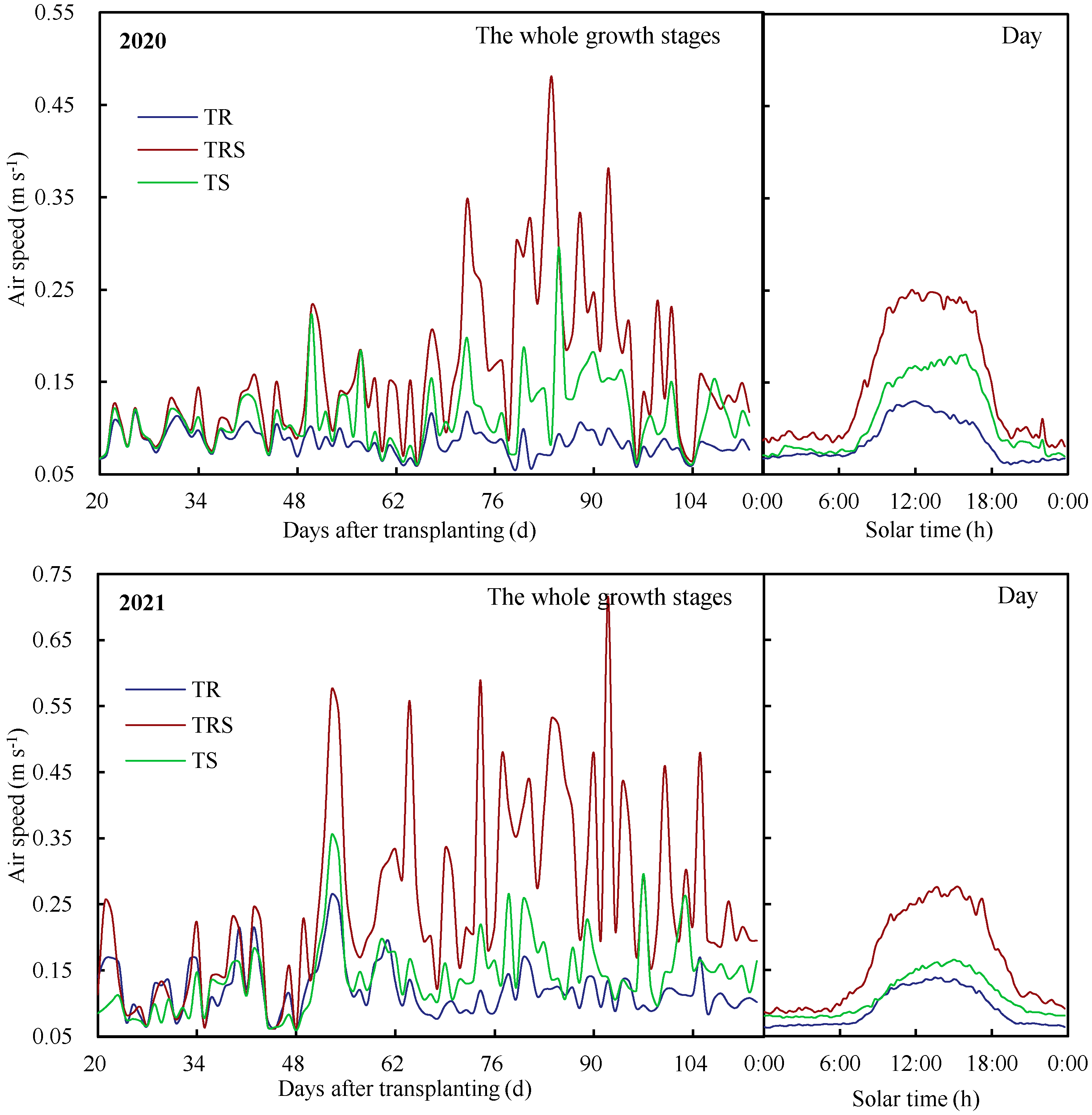
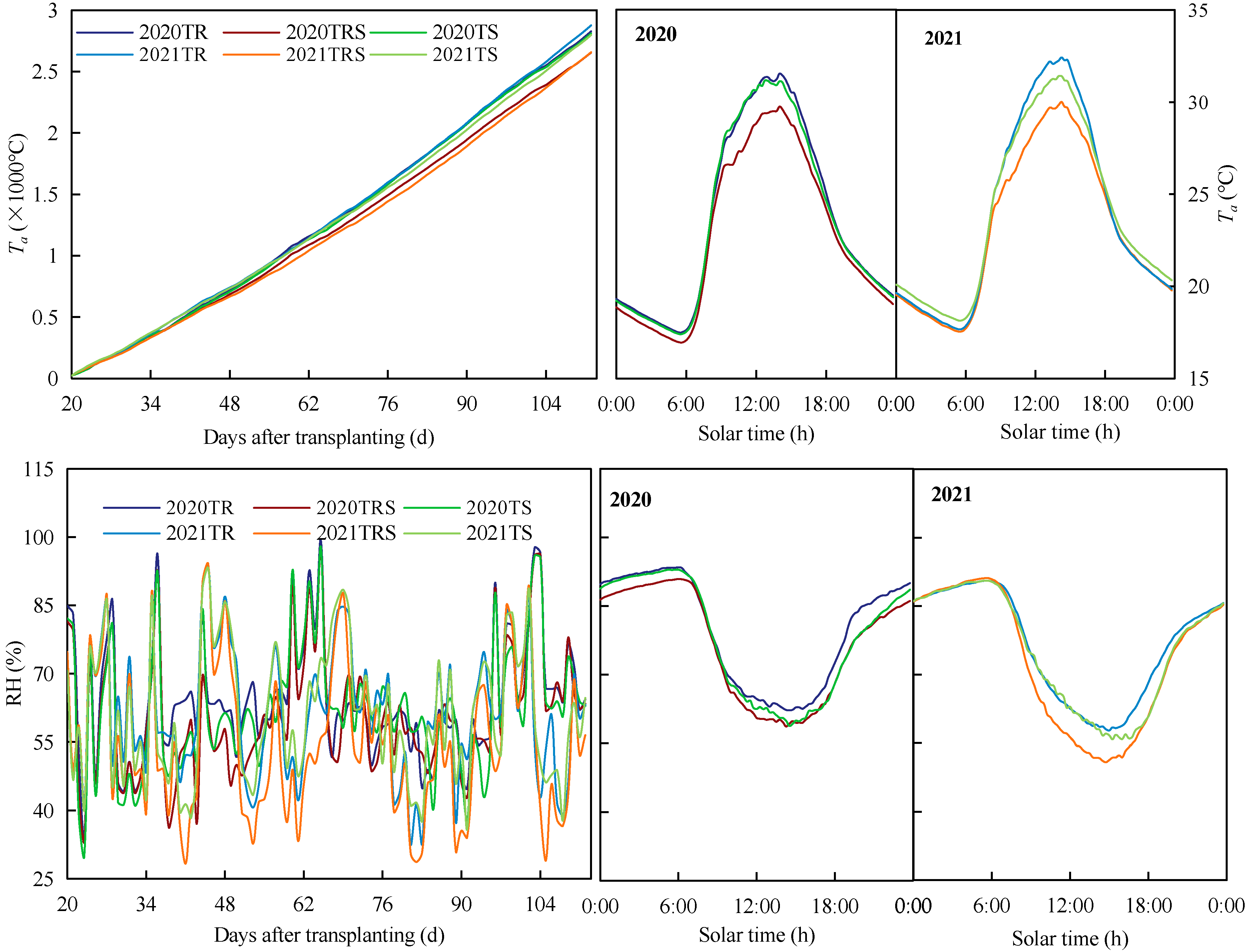
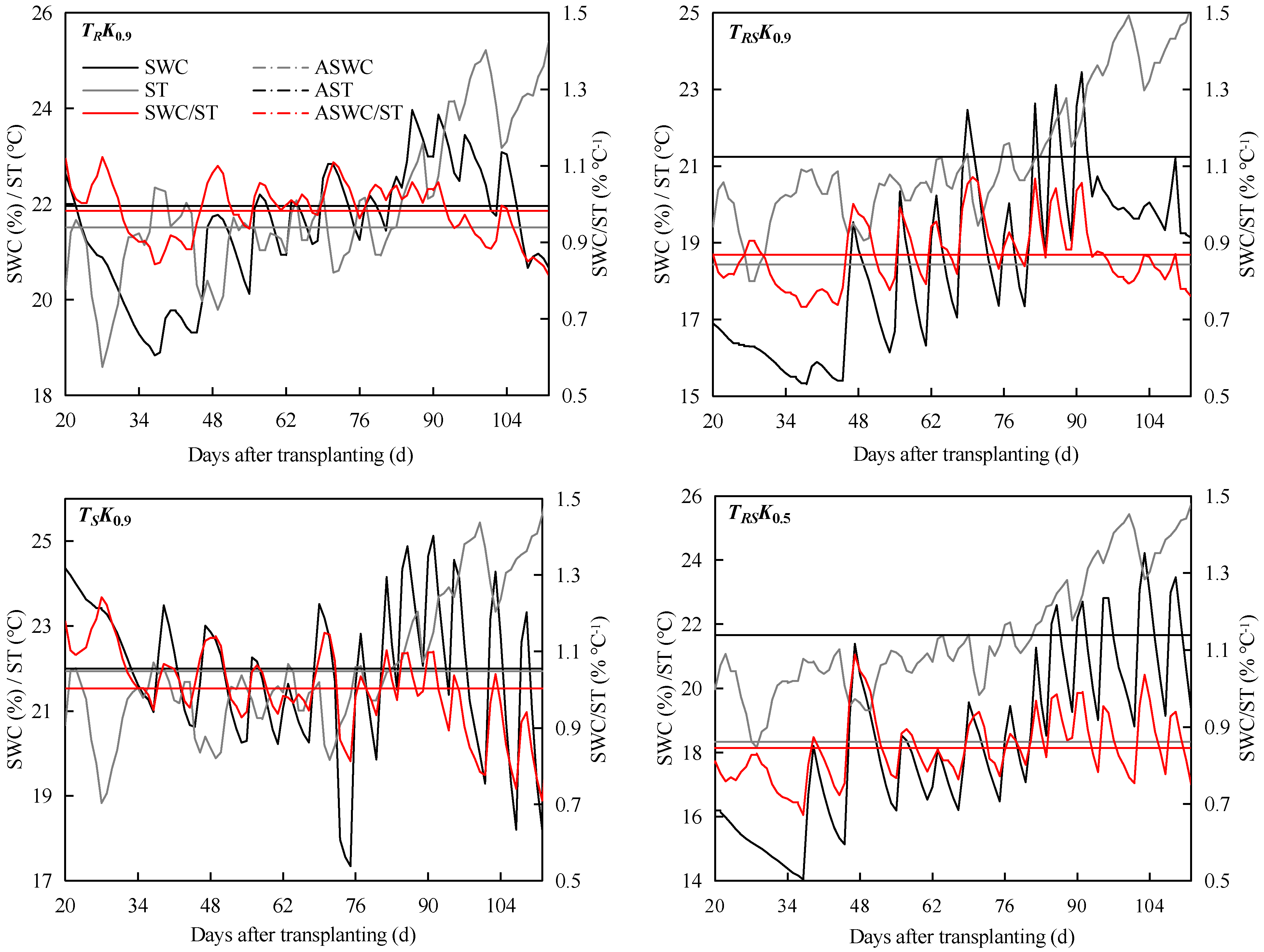
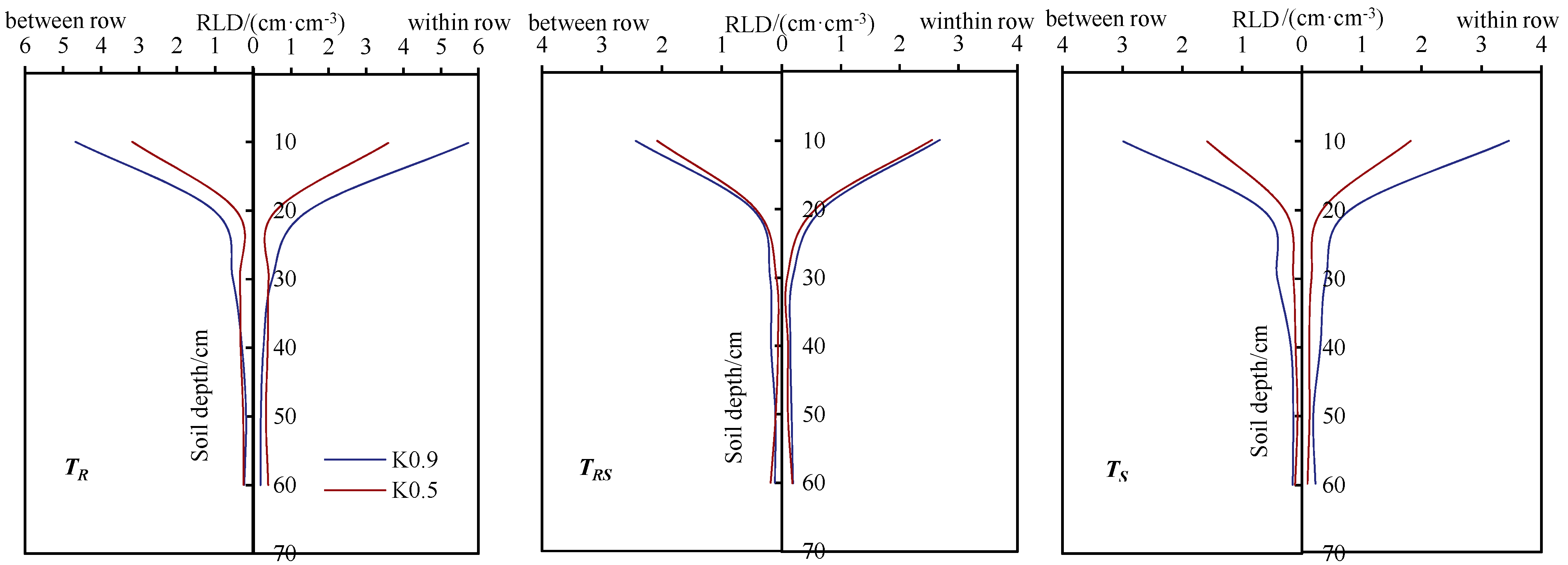

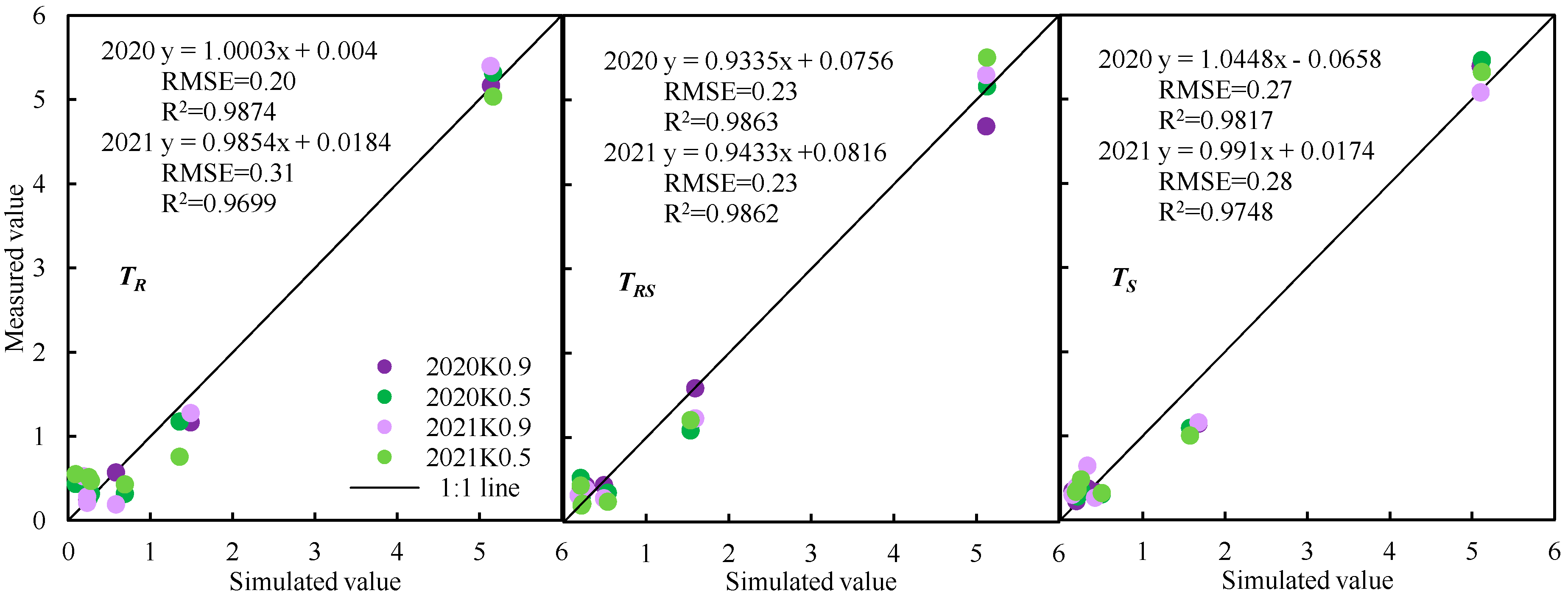

| Year | Treatment | Cropping Seasons | Time (9:00–17:00) | ||||
|---|---|---|---|---|---|---|---|
| TR | TRS | TS | TR | TRS | TS | ||
| 2020 | Air speed | 0.085 ± 0.00 c | 0.159 ± 0.01 a | 0.113 ± 0.01 b | 0.086 ± 0.00 c | 0.148 ± 0.01 a | 0.110 ± 0.01 b |
| Ta | 30.40 ± 0.62 a | 28.55 ± 0.54 b | 30.22 ± 0.62 a | 29.76 ± 0.25 a | 28.03 ± 0.22 b | 29.59 ± 0.24 a | |
| RH | 64.31 ± 1.39 a | 61.12 ± 1.42 b | 62.41 ± 1.44 ab | 65.40 ± 0.57 a | 62.44 ± 0.67 b | 64.56 ± 0.69 a | |
| 2021 | Air speed | 0.121 ± 0.01 b | 0.253 ± 0.02 a | 0.143 ± 0.01 b | 0.091 ± 0.00 c | 0.163 ± 0.01 a | 0.109 ± 0.00 b |
| Ta | 30.98 ± 0.59 a | 28.61 ± 0.58 b | 30.14 ± 0.52 ab | 30.23 ± 0.32 a | 28.09 ± 0.26 b | 29.52 ± 0.26 a | |
| RH | 61.52 ± 1.47 a | 54.90 ± 1.73 b | 61.18 ± 1.52 a | 62.80 ± 0.83 a | 56.28 ± 0.89 b | 62.05 ± 1.00 a | |
| Treatment | R0 | R1 | R2 | R3 | R2 | F |
|---|---|---|---|---|---|---|
| TRK0.9 | −82.33 | 134.68 | −70.78 | 12.19 | 0.985 | 19.29 ** |
| TRK0.5 | −97.16 | 152.77 | −75.68 | 12.15 | 0.9621 | 19.88 ** |
| TRSK0.9 | −80.79 | 130.72 | −67.75 | 11.57 | 0.9686 | 20.23 ** |
| TRSK0.5 | −86.21 | 140.18 | −72.73 | 12.28 | 0.9876 | 20.2 ** |
| TSK0.9 | −79.01 | 128.15 | −66.67 | 11.45 | 0.9775 | 19.94 ** |
| TSK0.5 | −80.80 | 131.13 | −68.36 | 11.74 | 0.9803 | 20.43 ** |
| Treatment | TRK0.9 | TRK0.5 | TRSK0.9 | TRSK0.5 | TSK0.9 | TSK0.5 |
|---|---|---|---|---|---|---|
| 2020 | 0.129 | 0.175 | 0.160 | 0.187 | 0.201 | 0.203 |
| 2021 | 0.193 | 0.273 | 0.159 | 0.195 | 0.209 | 0.220 |
| Location | Irrigation Treatment | Ventilation Treatment | Average Values | ||||||
|---|---|---|---|---|---|---|---|---|---|
| TR | TRS | TS | |||||||
| Simulated | Measured | Simulated | Measured | Simulated | Measured | Simulated | Measured | ||
| Zr = 1/4 | K0.9 | 73.9% | 71.8% | 74.3% | 68.4% | 74.7% | 74.5% | 74.3% | 71.6% |
| K0.5 | 73.4% | 73.8% | 74.1% | 71.2% | 74.3% | 75.1% | 73.9% | 73.4% | |
| Average | 73.7% | 72.8% | 74.2% | 69.8% | 74.5% | 74.8% | 74.1% | 72.5% | |
| Zr = 1/2 | K0.9 | 87.0% | 86.4% | 89.1% | 86.1% | 90.6% | 87.8% | 88.9% | 86.8% |
| K0.5 | 84.6% | 88.4% | 88.0% | 83.9% | 88.7% | 88.3% | 87.1% | 86.9% | |
| Average | 85.8% | 87.4% | 88.5% | 85.0% | 89.7% | 88.1% | 88.0% | 86.8% | |
| Year | Treatment | TRK0.9 | TRK0.5 | TRSK0.9 | TRSK0.5 | TSK0.9 | TSK0.5 |
|---|---|---|---|---|---|---|---|
| 2020 | Yield (t ha−1) | 139.5 ± 10.06 a | 124.2 ± 2.47 b | 147.6 ± 4.39 a | 119.4 ± 7.28 b | 143.1 ± 4.87 a | 125.1 ± 6.53 b |
| RLD (cm cm−3) | 4.85 ± 0.72 a | 4.35 ± 0.40 ab | 3.82 ± 0.28 bc | 3.02 ± 0.57 cd | 3.15 ± 0.43 cd | 2.39 ± 0.26 d | |
| 2021 | Yield (t ha−1) | 143.7 ± 9.23 ab | 128.5 ± 4.65 c | 148.1 ± 7.49 a | 126.3 ± 4.76 c | 144.5 ± 5.58 ab | 130.1 ± 7.24 bc |
| RLD (cm cm−3) | 6.58 ± 1.23 a | 5.22 ± 0.67 ab | 3.79 ± 0.81 bc | 3.27 ± 0.79 c | 4.97 ± 0.58 b | 2.50 ± 0.14 c |
| Ventilation Treatment | Irrigation Treatment | Soil Depth (cm) | Zr = 1/4 | Zr = 1/2 | |||||
|---|---|---|---|---|---|---|---|---|---|
| 10 | 20 | 30 | 40 | 50 | 60 | ||||
| TR | K1.0 | 5.13 | 1.52 | 0.22 | 0.22 | 0.55 | 0.21 | 84.77% | 90.32% |
| K0.8 | 5.14 | 1.46 | 0.17 | 0.23 | 0.60 | 0.23 | 84.26% | 89.36% | |
| K0.6 | 5.17 | 1.33 | 0.08 | 0.25 | 0.70 | 0.28 | 83.24% | 87.42% | |
| TRS | K1.0 | 5.11 | 1.63 | 0.29 | 0.20 | 0.46 | 0.17 | 85.63% | 91.96% |
| K0.8 | 5.12 | 1.57 | 0.25 | 0.21 | 0.51 | 0.19 | 85.18% | 91.11% | |
| K0.6 | 5.13 | 1.52 | 0.21 | 0.22 | 0.55 | 0.21 | 84.72% | 90.23% | |
| TS | K1.0 | 5.10 | 1.72 | 0.36 | 0.19 | 0.39 | 0.14 | 86.33% | 93.29% |
| K0.8 | 5.11 | 1.66 | 0.31 | 0.20 | 0.44 | 0.16 | 85.85% | 92.38% | |
| K0.6 | 5.13 | 1.56 | 0.24 | 0.22 | 0.52 | 0.20 | 85.04% | 90.85% | |
Disclaimer/Publisher’s Note: The statements, opinions and data contained in all publications are solely those of the individual author(s) and contributor(s) and not of MDPI and/or the editor(s). MDPI and/or the editor(s) disclaim responsibility for any injury to people or property resulting from any ideas, methods, instructions or products referred to in the content. |
© 2023 by the authors. Licensee MDPI, Basel, Switzerland. This article is an open access article distributed under the terms and conditions of the Creative Commons Attribution (CC BY) license (https://creativecommons.org/licenses/by/4.0/).
Share and Cite
Ge, J.; Liu, H.; Gong, X.; Yu, Z.; Li, L.; Li, Y. Root Distribution of Tomato Cultivated in Greenhouse under Different Ventilation and Water Conditions. Plants 2023, 12, 1625. https://doi.org/10.3390/plants12081625
Ge J, Liu H, Gong X, Yu Z, Li L, Li Y. Root Distribution of Tomato Cultivated in Greenhouse under Different Ventilation and Water Conditions. Plants. 2023; 12(8):1625. https://doi.org/10.3390/plants12081625
Chicago/Turabian StyleGe, Jiankun, Huanhuan Liu, Xuewen Gong, Zihui Yu, Lusheng Li, and Yanbin Li. 2023. "Root Distribution of Tomato Cultivated in Greenhouse under Different Ventilation and Water Conditions" Plants 12, no. 8: 1625. https://doi.org/10.3390/plants12081625
APA StyleGe, J., Liu, H., Gong, X., Yu, Z., Li, L., & Li, Y. (2023). Root Distribution of Tomato Cultivated in Greenhouse under Different Ventilation and Water Conditions. Plants, 12(8), 1625. https://doi.org/10.3390/plants12081625






